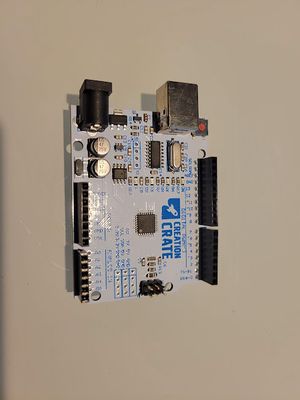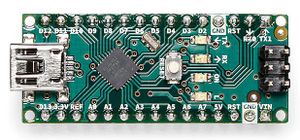Arduino: Difference between revisions
No edit summary |
No edit summary |
||
| Line 9: | Line 9: | ||
===Uno=== | ===Uno=== | ||
The Uno is one of the most popular models, and it's great for planning and testing before creating a new project. It features a microcontroller with 14 digital input/output pins, 6 analog inputs, a 16 MHz quartz crystal, a USB connection, and more. | The Uno is one of the most popular models, and it's great for planning and testing before creating a new project. It features a microcontroller with 14 digital input/output pins, 6 analog inputs, a 16 MHz quartz crystal, a USB connection, and more. | ||
* Microcontroller: ATmega328P | |||
* Operating Voltage: 5V | |||
* Input Voltage (recommended): 7-12V | |||
* Input Voltage (limits): 6-20V | |||
* Digital I/O Pins: 14 (of which 6 provide PWM output) | |||
* PWM Digital I/O Pins: 6 | |||
* Analog Input Pins: 6 | |||
* DC Current per I/O Pin: 20 mA | |||
* DC Current for 3.3V Pin: 50 mA | |||
* Flash Memory: 32 KB (ATmega328P) | |||
* SRAM: 2 KB (ATmega328P) | |||
* EEPROM: 1 KB (ATmega328P) | |||
* Clock Speed: 16 MHz | |||
===Nano=== | ===Nano=== | ||
[[File:Arduinonano.jpg|thumb|right|An Arduino Nano (Not my image).]] | [[File:Arduinonano.jpg|thumb|right|An Arduino Nano (Not my image).]] | ||
The Nano is a small, breadboard-friendly board based on the ATmega328P microcontroller. It has similar functionality to the Uno, but in a smaller form factor. It features 14 digital input/output pins, 8 analog inputs, a 16 MHz quartz crystal, a USB connection, and more. | The Nano is a small, breadboard-friendly board based on the ATmega328P microcontroller. It has similar functionality to the Uno, but in a smaller form factor. It features 14 digital input/output pins, 8 analog inputs, a 16 MHz quartz crystal, a USB connection, and more. | ||
* Microcontroller: ATmega328P | |||
* Operating Voltage: 5V | |||
* Input Voltage (recommended): 7-12V | |||
* Input Voltage (limits): 6-20V | |||
* Digital I/O Pins: 14 (of which 6 provide PWM output) | |||
* PWM Digital I/O Pins: 6 | |||
* Analog Input Pins: 8 | |||
* DC Current per I/O Pin: 20 mA | |||
* DC Current for 3.3V Pin: 50 mA | |||
* Flash Memory: 32 KB (ATmega328P) | |||
* SRAM: 2 KB (ATmega328P) | |||
* EEPROM: 1 KB (ATmega328P) | |||
* Clock Speed: 16 MHz | |||
==External Links== | ==External Links== | ||
Revision as of 21:50, 19 April 2023

Arduino is an open-source hardware and software company, project, and user community that designs and manufactures single-board microcontrollers and microcontroller kits for building digital devices. Arduino's mission is to make electronics accessible to everyone, from hobbyists and students to professionals and industrial designers.
The company offers a wide range of products, including boards, shields, kits, and accessories, all of which are designed to be easy to use and highly customizable. Arduino's software, including the integrated development environment (IDE), is also open source and free to use.
Models
Uno
The Uno is one of the most popular models, and it's great for planning and testing before creating a new project. It features a microcontroller with 14 digital input/output pins, 6 analog inputs, a 16 MHz quartz crystal, a USB connection, and more.
- Microcontroller: ATmega328P
- Operating Voltage: 5V
- Input Voltage (recommended): 7-12V
- Input Voltage (limits): 6-20V
- Digital I/O Pins: 14 (of which 6 provide PWM output)
- PWM Digital I/O Pins: 6
- Analog Input Pins: 6
- DC Current per I/O Pin: 20 mA
- DC Current for 3.3V Pin: 50 mA
- Flash Memory: 32 KB (ATmega328P)
- SRAM: 2 KB (ATmega328P)
- EEPROM: 1 KB (ATmega328P)
- Clock Speed: 16 MHz
Nano
The Nano is a small, breadboard-friendly board based on the ATmega328P microcontroller. It has similar functionality to the Uno, but in a smaller form factor. It features 14 digital input/output pins, 8 analog inputs, a 16 MHz quartz crystal, a USB connection, and more.
- Microcontroller: ATmega328P
- Operating Voltage: 5V
- Input Voltage (recommended): 7-12V
- Input Voltage (limits): 6-20V
- Digital I/O Pins: 14 (of which 6 provide PWM output)
- PWM Digital I/O Pins: 6
- Analog Input Pins: 8
- DC Current per I/O Pin: 20 mA
- DC Current for 3.3V Pin: 50 mA
- Flash Memory: 32 KB (ATmega328P)
- SRAM: 2 KB (ATmega328P)
- EEPROM: 1 KB (ATmega328P)
- Clock Speed: 16 MHz
External Links
Arduino's official website Arduino Create, a cloud-based platform for creating and managing Arduino projects Arduino's official forum
